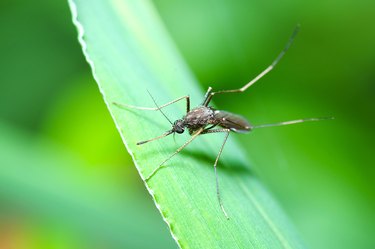
Self-water containers, also known as subirrigation planters, sit on perforated platforms right above water reservoirs with overflow holes on one side. The plant's roots grow through the medium and into the water with no drainage holes. How do they work, though? The water gets wicked up from the water reservoir into the growing medium; they are kind of like conventional hybrid containers or hydroponic gardening systems.
Pros and Problems With Subirrigation Planters
Video of the Day
The wicking systems in these planters are made out of absorbent materials, like strips of cloth or rope. One end is in the soil, and the other is in the water. Self-wicking containers are convenient to use, as they irrigate plants on their own, and you won't need to worry about the soil drying out. They also conserve water and prevent plants from getting overwatered. They are great for when you go on vacation, and they are available in a variety of styles.
Video of the Day
On the downside, self-wicking tubs are not appropriate for plants that need very moist soil, like umbrella palms. They also release water no matter how dry or wet the weather may be, so plants may become waterlogged. This waterlogging can cause root rot, stagnated growth, fungi and even plant death. Another issue that can occur is mosquito infestations. These insects lay eggs in the water and then multiply swiftly, quickly turning into a real problem.
How to Keep Mosquitoes Out of Potted Plants
Mosquitoes are attracted to standing water, so self-wicking containers are a natural breeding ground for these pests. You might want to keep these plants indoors, but that might not always be an option. If you must keep them outside, switch out those lights for LEDs and yellow bug lights, also known as sodium lamps. Also, you should aim floodlights away from your outdoor living areas and use citronella candles, wax candles and oil lamps on your patio tables.
You can also try an all-natural repellent spray for your container plants, which is an easy homemade recipe that shouldn't take more than an hour or two. Cook a few pieces of garlic in cooking oil and let them simmer for about an hour. Let the pan cool for several minutes, strain the oil and pour it into a spray bottle. You can spritz this right onto the plants; citrus spray and lemon balm are also believed to work.
What Else Repels Mosquitoes?
Many plants can repel mosquitoes, and you can plant these in self-watering containers. One is allium, but you should remember that these perennials can grow up to 4 feet high. These insects are also known to avoid basil, catnip, chives, chrysanthemums, lavender, lemongrass, oregano, marigolds, sage and peppermint. That's a long list, and you can use many of these when cooking.
Another option is to use mosquito bits. They are made from natural, nontoxic mosquito larvicides that are toxic to mosquitoes. This all-natural insecticide kills the larvae before they can mature into biting pests. You can use it in self-watering containers, ponds, water gardens and rain barrels, and it is safe to use around humans, pets and wildlife. To use it, sprinkle 1 teaspoon for every 25 square feet over the standing water every two weeks. You'll need to use less for small self-water containers.